Together with the research group from Margaret McFall-Ngai in the USA, scientists from Kiel University and the University Hospital Schleswig-Holstein, Campus Kiel, have now discovered the mechanisms that occur when newborn squid enter into dialogue with glowing, symbiotic bacteria. The study’s results were published in the current edition of Cell Host & Microbe.
A symbiosis is the cohabitation of different species with benefits on both sides. The Hawaiian Bobtail Squid, Euprymna scolopes, buries itself under the sea floor for camouflage during the day. At night, when foraging, it throws a shadow against the brighter sea surface. In order to protect itself from predators it enters into symbiosis with the marine bacteria Vibrio fischeri. In this way it is disguised by a light organ in which the bacteria settle and glow.
The squid is born sterile, yet comes into contact with thousands of species of bacteria during their first hours of life. In that time the one type of bacteria that is useful must be picked out. It is already known that less than five “fitting” bacteria suffice in order to give the decisive signal for symbiosis. “Newborn humans behave in a similar way. We meet a large number of bacteria species. Our immune system actively chooses the types with which we will enter into a stable and partly even lifelong coexistence,” describes Professor Philip Rosenstiel from Kiel University’s Institute of Clinical Molecular Biology. The method of communication between host and microbe was unknown up to now.
The scientists participating in the study were able to solve the exact molecular mechanisms that lead to a successful symbiosis. Natacha Kremer from the Lyon University in France and first author of the study, reports that the first few bacteria that attach themselves to the squid cause extensive changes in the animal’s cellular coding. Specific genes are activated and thus the enzyme Chitin produced, which converts part of the surface into a sugar. The Vibrio fischeri bacteria are attracted by this and move along a gradient on the surface of the squid into the squid’s inside. “What is special about this study is that we have managed to uncover the specific signal of first contact with very few cells,” says Rosenstiel.
The genetic analysis for this study was performed by Kremer in Rosenstiel’s laboratory at Kiel University in cooperation with the interdisciplinary marine scientific research in Kiel’s Cluster of Excellence “The Future Ocean”. “The study’s results help us to improve our understanding of the bacterial symbiosis in humans. Thousands of species of bacteria live in the human intestine. They react to the surroundings und change the host’s program,” says Rosentstiel. “This dialogue is made up of many small, individual signals from different cells but now we know what the first contact with useful bacteria can look like.” The results are also important for understanding immune reactions which are the subject of research in Kiel’s Cluster of Excellence “Inflammation at Interfaces” and thus demonstrate the interdisciplinary cooperation between the two Clusters.
Links:
www.sciencedirect.com/science/article/pii/S1931312813002540 Original publication
www.news.wisc.edu/22026 News of the University of Wisconsin-Madison
Contactt:
Prof. Philip Rosenstiel, Institut für Klinische Molekularbiologie
Tel.: 0431 597-5101, p.rosenstiel@mucosa.de
Dr. Boris Pawlowski, Presse, Kommunikation und Marketing, Christian-Albrechts-Universität zu Kiel
Tel. 0431-880-3004, bpawlowski@uv.uni-kiel.de
…



